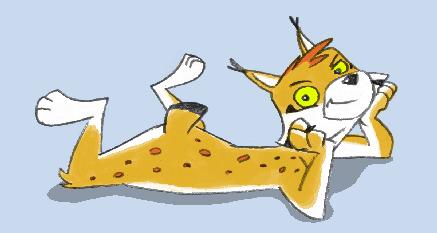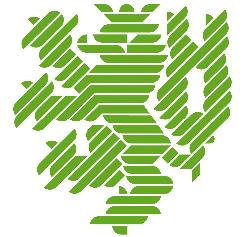Matthias Ehrhardt
'Publish or Perish'
Modellierung der Vertrauenswürdigkeit der Wissenschaft
|
 |
Materialien für Interessierte zum Vortrag am
Die Zielgruppe sind Schüler ab der 11. Klasse.
|
 |
|

Das MATEMA-Logo (ein Luchs, copyright by Ulf Grenzer)
Beschreibung
Wissenschaftliche Veröffentlichungen sind für den Fortschritt der Wissenschaft von enormer Bedeutung.
Es besteht jedoch die Befürchtung, dass die Belohnung von Wissenschaftlern, die hauptsächlich Forschungsartikel
veröffentlichen, einen ungewollten Anreiz schafft und sorglose und betrügerische Verhaltensweisen fördert.
Dies führt potenziell zu einer Reproduzierbarkeitskrise in verschiedenen Bereichen, wie z.B. Medizin, Biologie.
Zudem wird das Vertrauen in wissenschaftliche Erkenntnisse untergraben.
Bisher gibt es vergleichsweise wenige Modellierungen zu Faktoren, die die Vertrauenswürdigkeit
von Wissenschaft beeinflussen.
Wir präsentieren ein einfaches phänomenologisches Modell bei dem die eingeworbene Finanzierung mit
der Anzahl der veröffentlichten Forschungsartikel zusammenhängt.
Diese Analyse legt nahe, dass die Vertrauenswürdigkeit der veröffentlichten Wissenschaft
unter anderem durch den Druck auf positive Ergebnisse negativ beeinflusst wird.
Es zeigt sich, dass die Verringerung der verfügbaren Forschungs-Budgets negative Folgen auf die
Vertrauenswürdigkeit hat und wir überprüfen Strategien, um die
Ausbreitung der nicht reproduzierbaren Wissenschaft zu bekämpfen.

Das MATEMA-Logo (ein Luchs, copyright by Ulf Grenzer)
Referenzen für den Vortrag
- R. Al-Shahi Salman, E. Beller, J. Kagan et al.,
Increasing value and reducing waste in biomedical research regulation and management,
Lancet 383 (2014), 176-185.
- N. Altman, M. Krzywinski,
Points of significance: P values and the search for significance,
Nat. Methods 14 (2016), 3-4.
- M. Baker,
Is there a reproducibility crisis?,
Nature 533 (2016), 452- 454.
- C.G. Begley, J.P.A. Ioannidis,
Reproducibility in science: improving the standard for basic and preclinical research,
Circ. Res. 116 (2015), 116-126.
- C.G. Begley, L.M. Ellis,
Drug development: raise standards for preclinical cancer research,
Nature 483 (2012), 531-533.
- L. Bornmann, R. Mutz,
Growth rates of modern science: a bibliometric analysis based on the
number of publications and cited references,
J. Assoc. Inf. Sci. Technol. 66 (2015), 2215-2222.
- D. Chavalarias, J.D. Wallach, A.H.T. Li, J.P.A. Ioannidis,
Evolution of reporting P values in the biomedical literature, 1990-2015,
JAMA 315 (2016), 1141-1148.
- L.D. Claxton,
Scientific authorship: Part 1. A window into scientific fraud?,
Mutat. Res. / Rev. Mutat. Res. 589 (2005), 17-30.
- D. Colquhoun,
An investigation of the false discovery rate and the misinterpretation of p-values,
R. Soc. open sci. 1 (2014), 1-15.
- D. Cyranoski,
Failed replications put STAP stem-cell claims to rest,
Nature News, 23. September 2015.
- P. Davis,
Scientific Reports overtakes PLoS ONE as largest megajournal,
Scholarly Kitchen, 2017.
- R. de Vries, M.S. Anderson, B.C. Martinson,
Normal misbehavior: scientists talk about the ethics of research,
J. Empir. Res. Hum. Res. Ethics: Int. J. 1 (2006), 43-50.
- M.A. Edwards, S. Roy,
Academic research in the 21st Century: maintaining scientific integrity in a
climate of perverse incentives and hypercompetition,
Environ. Eng. Sci. 34 (2016), 51-61.
- D. Fanelli, R. Costas, J.P. Ioannidis,
Meta-assessment of bias in science,
Proc. Natl Acad. Sci. USA 114 (2017), 3714-3719.
- D. Fanelli,
Do pressures to publish increase scientists' bias? An empirical support from US states data,
PLoS ONE 5 (2010), e10271.
- D. Fanelli,
How many scientists fabricate and falsify research?
A systematic review and meta-analysis of survey data,
PLoS ONE 4 (2009), e5738.
- F.C. Fang, R.G. Steen, A. Casadevall,
Misconduct accounts for the majority of retracted scientific publications,
Proc. Natl Acad. Sci. USA 109 (2012), 17 028-17 033.
- A. Franco, N. Malhotra, G. Simonovits,
Publication bias in the social sciences: unlocking the file drawer,
Science 345 (2014), 1502-1505.
- A. Franco, N. Malhotra, G. Simonovits,
Publication of NIH funded trials registered in ClinicalTrials.gov: cross sectional analysis,
Br. Med. J. 344 (2012), d7292.
- M. Franzen, S. Rödder, P. Weingart,
Fraud: causes and culprits as perceived by science and the media,
EMBO Rep. 8 (2007), 3-7.
- S. Fuchs, S.D. Westervelt,
Fraud and trust in science,
Perspect. Biol. Med. 39 (1996), 248-269.
- W. Gardner, C.W. Lidz, K.C. Hartwig
Authors' reports about research integrity problems in clinical trials,
Contemp. Clin. Trials 26 (2005), 244-251.
- J. Giles,
Special report: taking on the cheats,
Nature 435 (2005), 258-259.
- J.L. Glick,
Scientific data audit - a key management tool,
Account. Res. 2 (1992), 153-168.
- D.R. Grimes, C.T. Bauch, J.P.A. Ioannidis,
Modelling science trustworthiness under publish or perish pressure,
R. Soc. open sci. 5 (2017), 171511.
- D.R. Grimes,
On the viability of conspiratorial beliefs,
PLoS ONE 11 (2016), e0151003.
- L.G. Halsey, D. Curran-Everett, S.L. Vowler, G.B. Drummond,
he fickle P value generates irreproducible results,
Nat. Methods 12 (2015), 179-185.
- J.P.A. Ioannidis,
Why most published research findings are false,
PLoS Med. 2 (2005), e124.
- J.P. Ioannidis,
How to make more published research true,
PLoS Med 11 (2014), e1001747.
- J.P. Ioannidis, M.J. Khoury,
Assessing value in biomedical research: the PQRST of appraisal and reward,
J. Am. Med. Assoc. 312 (2014), 483-484.
- L.K. John, G. Loewenstein, D. Prelec,
Measuring the prevalence of questionable research practices with incentives for truth telling,
Psychol. Sci. 23 (2012), 524-532.
- M. Krawczyk,
The search for significance:
a few peculiarities in the distribution of p values in experimental psychology literature,
PLoS ONE 10 (2015), e0127872.
- P.A. Lawrence,
The politics of publication,
Nature 422 (2003), 259-261.
- B.C. Martinson, M.S. Anderson, R. de Vries,
Scientists behaving badly,
Nature 435 (2005), 737-738.
- R. McElreath, P.E. Smaldino,
Replication, communication, and the population dynamics of scientific discovery,
PLoS ONE 10 (2015), 1e0136088.
- M.R. Munafò et al.,
A manifesto for reproducible science,
Nat. Human Behav. 1 (2017), 1-9.
- U.S. Neill,
Publish or perish, but at what cost?,
J. Clin. Investig. 118 (2008), 2368-2368.
- S.I. Papatheodoroua, T.A. Trikalinos, J.P.A. Ioannidis,
Inflated numbers of authors over time have not been just due to increasing research complexity,
J. Clin. Epidemiol. 61 (2007), 546-551.
- J. Ranstam,
Fraud in medical research: an international survey of biostatisticians.
ISCB subcommittee on fraud,
Control. Clin. Trials 21 (2000), 415-427.
- J. Rasko, C. Power,
What pushes scientists to lie? the disturbing but familiar story of Haruko Obokata,
The Guardian, 2015.
- S. Rawat, S. Meena,
Publish or perish: where are we heading?,
J. Res. Med. Sci. 19 (2014), 87-89.
- S.J. Ritchie, R. Wiseman, C.C. French,
Failing the future: three unsuccessful attempts to replicate Bem's 'retroactive facilitation of recall' effect,
PLoS ONE 7 (2012), e33423.
- R. Rosenthal,
The file drawer problem and tolerance for null results,
Psychol. Bull. 86 (1979), 638-641.
- E. Rothstein,
Plagiarism that Doesn't Add Up,
The New York Times, March 9, 2002.
- M. Scudellari,
A timeline of the Wakefield retraction,
Nat. Med. 16 (2010), 248-248.
- K.C. Siontis, E. Evangelou, J.P. Ioannidis,
Magnitude of effects in clinical trials published in high-impact general medical journals,
Int. J. Epidemiol. 40 (2011), 1280-1291.
- P.E. Smaldino, R. McElreath,
The natural selection of bad science,
R. Soc. open. sci. 3 (2016), 160384.
- N. Steneck,
Fostering integrity in research: definition, current knowledge, and future directions,
Sci. Eng. Ethics 12 (2006), 53-74.
- J.K. Tijdink, A.C.M. Vergouwen, Y.M. Smulders
Publication pressure and burn out among Dutch medical professors: a nationwide survey,
PLoS ONE 8 (2013), e73381.
- M.A.G. van der Heyden, T. van de Ven, T. Opthof,
Fraud and misconduct in science: the stem cell seduction: implications for the peer-review process,
Neth. Heart. J. 17 (2009), 25-29.
- D. van Dijk, O. Manor, L.B. Carey,
Publication metrics and success on the academic job market,
Curr. Biol. 24 (2014), R516-R517.
- M. van Wesel,
Evaluation by citation: trends in publication behavior, evaluation criteria, and the
strive for high impact publications,
Sci. Eng. Ethics 22 (2016), 199-225.
- G. Vogel,
Jan Hendrik Schön loses his PhD,
Science News, 2011.
- A. Williamson,
COPE: committee on publication ethics,
Learn. Publ. 14 (2001), 149-150.
Links:
- Betrug und Fälschung in der Wissenschaft (Wikipedia)
-
Obokata manipulierte und plagiierte (Tagesspiegel, April 2014)
- Timeline: The Rise and Fall of Haruko Obokata in 2014 (The Wall Street Journal, Dec 2014)
Software:





